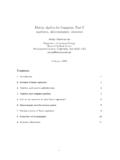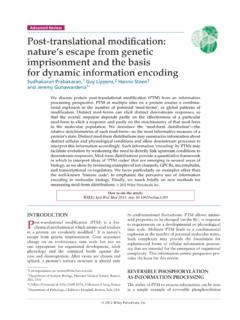Transcription of Matrix algebra for beginners, Part I matrices ...
1 Matrix algebra for beginners, part Imatrices, determinants , inversesJeremy GunawardenaDepartment of Systems BiologyHarvard Medical School200 Longwood Avenue, Cambridge, MA 02115, January 2006 Contents1 Introduction12 Systems of linear equations13 matrices and Matrix multiplication24 matrices and complex numbers55 Can we use matrices to solve linear equations?66 determinants and the inverse matrix77 Solving systems of linear equations98 Properties of determinants109 Gaussian elimination1111 IntroductionThis is a part I of an introduction to the Matrix algebra needed for the Harvard Systems Biology101 graduate course.
2 Molecular systems are inherently many dimensional there are usually manymolecular players in any biological system and linear algebra is a fundamental tool for thinkingabout many dimensional systems. It is also widely used in other areas of biology and will describe the main concepts needed for the course determinants , Matrix inverses, eigenvaluesand eigenvectors and try to explain where the concepts come from, why they are important andhow they are used. If you know some of the material already, you may find the treatment here quiteslow.
3 There are mostly no proofs but there are worked examples in low dimensions. New conceptsappear in italics when they are introduced or defined and there is an index of important items atthe end. There are many textbooks on Matrix algebra and you should refer to one of these for moredetails, if you need to Matt Thomson for spotting various bugs. Any remaining errors are my me know if you come across any or have any Systems of linear equationsMatrices first arose from trying to solve systems of linear equations.
4 Such problems go back to thevery earliest recorded instances of mathematical activity. A Babylonian tablet from around 300 BCstates the following problem1:There are two fields whose total area is 1800 square yards. One produces grain at therate of 2/3 of a bushel per square yard while the other produces grain at the rate of 1/2a bushel per square yard. If the total yield is 1100 bushels, what is the size of each field?If we letxandystand for the areas of the two fields in square yards, then the problem amounts tosaying thatx+y= 18002x/3 +y/2 = 1100.
5 (1)This is a system of twolinear equationsin two unknowns. Thelinearrefers to the fact that theunknown quantities appear just asxandy, not as 1/xory3. Equations with the latter terms arenonlinearand their study forms part of a different branch of mathematics, calledalgebraic speaking, it is much harder to say anything about nonlinear equations. However, linearequations are a different matter: we know a great deal about them. You will, of course, have seenexamples like (1) before and will know how to solve them.
6 (So what is the answer?). Let us considera more general problem (this is the kind of thing mathematicians love to do) in which we do notknow exactly what the coefficients are (ie: 1, 2/3, 1/2, 1800, 1100):ax+by=ucx+dy=v ,(2)and suppose, just to keep things simple, that none of the numbersa,b,cordare 0. You should beable to solve this too so let us just recall how to do it. If we multiply the first equation by (c/a),which we can do becausea6= 0, and subtract the second, we find that(cb/a)y dy=cu/a v.
7 1 For an informative account of the history of matrices and determinants , history/ (ad bc)6= 0, we can divide across and find thaty=av cuad bc.(3)Similarly, we find thatx=ud bvad bc.(4)The quantity (ad bc), which we did not notice in the Babylonian example above, turns out tobe quite important. It is adeterminant. If it is non-zero, then the system of equations (2) alwayshas a unique solution: the determinant determines whether a solution exists, hence the name. Youmight check that it is indeed non-zero for example (1).
8 If the determinant is zero, the situation getsmore interesting, which is the mathematician s way of saying that it gets a lot more onu, v, the system may have no solution at all or it may have many solutions. Youshould be able to find some examples to convince yourself of these of the benefits of looking at a more general problem, like (2) instead of (1), is that you often learnsomething, like the importance of determinants , that was hard to see in the more concrete us take this a step further (generalisation being an obsessive trait among mathematicians).
9 Howwould you solve a system of 3 equations with 3 unknowns,ax+by+cz=udx+ey+f z=vgx+hy+iz=w ,(5)or, more generally still, a system ofnequations withnunknowns?You think this is going too far? In 1800, when Carl Friedrich Gauss was trying to calculate theorbit of the asteroid Pallas, he came up against a system of 6 linear equations in 6 unknowns.(Astronomy, like biology, also has lots of moving parts.) Gauss was a great mathematician perhapsthe greatest and one of his very minor accomplishments was to work out a systematic version of thetechnique we used above for solving linear systems of arbitrary size.
10 It is calledGaussian eliminationin his honour. However, it was later discovered that the Nine Chapters of the Mathematical Art ,a handbook of practical mathematics (surveying, rates of exchange, fair distribution of goods, etc)written in China around the 3rd century BC, uses the same method on simple examples. Gaussmade the method into what we would now call analgorithm: a systematic procedure that can beapplied to any system of equations. We will learn more about Gaussian elimination in 9 modern way to solve a system of linear equations is to transform the problem from one aboutnumbers and ordinary algebra into one about matrices and Matrix algebra .


